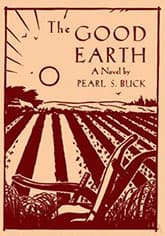The Good Earth
Critique • Quotes • At the movies
 First edition
First editionFirst publication
1931, United States
Literature form
Novel
Genres
Literary, historical fiction
Writing language
English
Author's country
United States
Length
Approx. 137,000 words
Simply true
Pearl S. Buck has sometimes been accused of stereotyping the Chinese peasants as noble, simple creatures. But this was hardly the reaction to The Good Earth in the early 1930s when it became a sensation in the West and when the slightly more sentimental movie based on it was released a few years later. Nor is the charge justified today.
Yes, the characters in The Good Earth often appear uncomplicated—in their speech, their aspirations and their social relations—but they are after all, uh, peasants.
And usually not all that noble either, except for the main character's selfless, quietly suffering wife, O-lan. The rest, including his relatives and fellow villagers are a self-centred lot, trained by the hard-scrabble life to look out for themselves and their families first.
"Deceptively simple" may be the most apt description of The Good Earth, both in its characterizations and in its writing style. It's a classic of understated storytelling. Much less sentimental than one might expect if familiar with the usual plot synopsis of something like "The moving, epic story of poor Chinese farmer Wang Lung who survives on the land through famine and feast and grows wealthy, only to lose the wife who had helped him get ahead."
This is a book you live in—starting small with Wang's mud abode, his modest marital hopes, his dreams and fears for his meagre crops ... and gradually expanding to take in more people, more land, and more tumultuous events ranging beyond his rural valley.
The novel is in many aspects similar to that other American-written masterpiece of hard times among the salt of the earth, The Grapes of Wrath—but taking place on the other side of the world and with a less direct political message.
Before the revolution
For today's readers the harsh times and the political situation of foreign invasion and imminent revolution might make one think of the 1930s prior to World War II and the Communist revolution. But, as far as I can tell, The Good Earth is situated in the late 1800s and early 1900s, well before the Chinese republican revolution of the early twentieth century and World War I.
But this is touched on only insofar as it affects the fortunes of Wang's family. Oddly our sympathies remain with the ambitious and sometimes cruel farmer throughout the novel, even as we feel sorry for the neglected O-lan. Even as the wealth goes to his head and he parades about as the local rich man with perfumed lovers and grasping kinfolk.
Only great writing can accomplish this. We understand, even as we condemn. I don't know how accurate a portrait it is of the lives and minds of Chinese farmers of a certain era, but it is a true rendering of a kind of human life and mentality, perhaps even ours.
And it is very moving, as the blurbs say, but not always as the blurbs might lead you to expect.
The earth may be good at times, but it can also be rock hard.
— Eric
Critique • Quotes • At the movies

